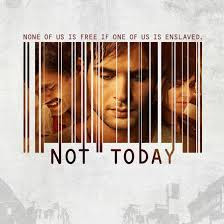Opening at 3,719 locations—and with $2.2 million in the bank already from Wednesday night showings—G.I. Joe: Retaliation is the follow-up to 2009 hit G.I. Joe: The Rise of Cobra. After Paramount/Hasbro scored with the first Transformers movie in 2007, they decided to move forward with bringing the popular G.I. Joe toys to the big screen as well; while Cobra didn't come close to matching Transformers, it still earned a solid $150.2 million domestically and another $152 million overseas. Unfortunately, it was largely reviled by audiences, and currently has an atrocious 5.7 rating on IMDb (really, really low for a genre movie like this).
In a tacit acknowledgement of how disappointing the first movie was, producers did a major revamp for the sequel. Stars from that movie like Dennis Quaid, Marlon Wayans and Sienna Miller weren't brought back, while Channing Tatum took on a much smaller role. Meanwhile, big name action stars The Rock and Bruce Willis were brought on board, and director Jon Chu was hired to replace Stephen Sommers.
Retaliation was originally scheduled for June 2012, and Paramount even went so far as to buy a pricey commercial spot during the 2012 Super Bowl. However, around five weeks ahead of release—and right after Hasbro's Battleship bombed—Paramount abruptly decided to push Retaliation back to March 2013 in order to post-convert the movie to 3D and to add in more scenes with Channing Tatum, whose star power had increased coming off The Vow and 21 Jump Street.
If the delay might suggest a lack of confidence in the product, Paramount sure isn't showing it with their marketing effort: as alluded to earlier, they've gone all out to position Retaliation as the first major event movie of the year (I guess they forgot Oz opened to nearly $80 million a few weeks ago?). The ubiquitous advertisements pack a lot of story in: they raise the stakes with the destruction of London, and give the movie an appealing renegade attitude with the disavowing of the Joes. Commercials have also emphasized the presence of The Rock and Channing Tatum, though surprisingly some of them ignore Bruce Willis.
The first G.I. Joe movie opened to $54.7 million; combine that movie's poor reputation with unexpectedly strong competition from Olympus Has Fallen and it could be tough for Retaliation to match that figure in its first four days. Paramount is expecting a modest $40 million, which would be slightly disappointment. Retaliation is also opening in 75 percent of foreign markets this weekend—including major territories Australia, Brazil, France, Germany, Italy, South Korea, Mexico, Russia, Spain, and the U.K.—and Paramount is anticipating around $40 million there as well.
 While G.I. Joe is the obvious front-runner, two other interesting movies are also opening nationwide this weekend. The first of those is The Host, a sci-fi romance that Open Road Films is releasing at 3,202 locations this weekend.
While G.I. Joe is the obvious front-runner, two other interesting movies are also opening nationwide this weekend. The first of those is The Host, a sci-fi romance that Open Road Films is releasing at 3,202 locations this weekend.After wrapping up with the Twilight series, author Stephanie Meyer tried her hand at sci-fi with The Host, which was published in 2008. The book sold tons of copies, but the reactions were generally lukewarm, and sequels have yet to be released.
As Beautiful Creatures proved last month, it's increasingly difficult to replicate the success of Twilight or The Hunger Games (or even modest young-adult hits like Percy Jackson & The Olympians). Obviously, there is an established fan base for these works, but reaching outside of that base is difficult, and The Host's campaign hasn't really addressed the uninitiated in any significant way. Distributor Open Road is hoping to open to at least $11 to $12 million; that's a very reasonable level, though cracking $20 million looks unreachable.
Tyler Perry's Temptation: Confessions of a Marriage Counselor marks the fourth time that distributor Lionsgate has released a Tyler Perry movie at Easter. The first three—Madea's Big Happy Family, Why Did I Get Married Too? and Meet the Browns—all opened between $20 and $30 million, which is a fairly standard level for Perry movies.
Temptation is at a slight disadvantage, though, because of its heavy infidelity subject matter: Perry's most successful outings have been light comedies, and more dramatic work like For Colored Girls and Good Deeds opened below $20 million. That's likely going to be the case with Temptation as well; Lionsgate is expecting mid-teen-millions.
Focus Features is releasing Derek Cianfrance's The Place Beyond the Pines in to four theaters in New York and Los Angeles this weekend. With good reviews and an impressive cast that includes Ryan Gosling and Bradley Cooper, the movie should earn at least $50,000 per-theater this weekend, and Focus Features will likely push the movie towards nationwide release through April.
Forecast (March 29-31)
1. G.I. Joe: Retaliation - $37.3 million ($48.4 million four-day)
2. The Croods - $27.1 million (-38%)
3. Temptation - $18.1 million
4. Olympus Has Fallen - $17.9 million (-41%)
5. The Host - $14.4 million
6. Oz - $11.9 million (-45%)
Bar for Success
The first G.I. Joe grossed $54.7 million in three days, and with an improved cast the sequel really ought to be grossing $50 million through its first four days. With a huge release and an established fanbase, The Host should be getting to high-teen-millions at least, while Temptation is fine if it starts over $15 million.



























